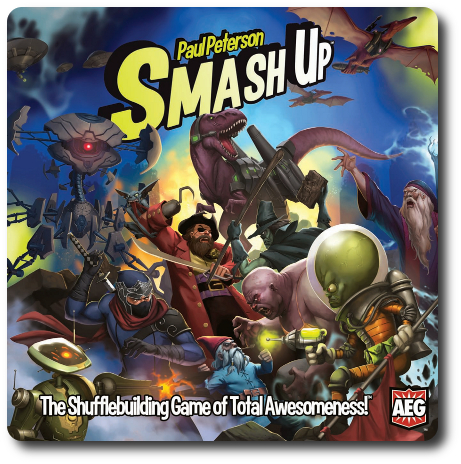
The Basics:
- For ages 12 and up
- For 2 to 4 players
- Approximately 45 minutes to complete
Geek Skills:
- Counting & Math
- Reading
- Logical & Critical Decision Making
- Hand/Resource Management
- Strategy & Tactics
Learning Curve:
- Child – Moderate
- Adult – Easy
Theme & Narrative:
- Wizards, Pirates, Zombies, Robots, and more team up to wage epic battles of geekery
Endorsements:
- Gamer Geek approved!
- Parent Geek approved!
- Child Geek approved!
Purchase:
Overview
The premise of Smash Up is pretty simple. Take two of the eight Faction decks (that represent iconic heroes of geek culture) and shuffle them together to create a 40 card deck. Use Minions and Actions from that deck to attack and destroy the Bases before your opponent’s do. The faster you destroy a Base, the more Victory Points you earn. The first player to accumulate 15 Victory Points wins the game.
Game components include…
- 8 different factions comprised of 20 cards each (160 cards in total with a mix of Minion and Action cards specific to each faction)
- 16 Base cards
Game Set Up
To set up the game, first separate each faction into its own Faction deck and place the eight Faction decks on the table. The factions represented in the game are Aliens, Dinosaurs, Ninjas, Pirates, Robots, Tricksters, Wizards, and Zombies.
Second, determine who is going to be the first player and have them select their first Faction deck. Selection of the first Faction deck then proceeds to the left (clockwise), with each player selecting a single Faction deck each.
Third, the last player to select a Faction deck now selects their second Faction deck. Selection of the second Faction deck then proceeds to the right (counter-clockwise). Any unclaimed Faction decks are returned to the game box.
Fourth, each player shuffles their two Faction decks together. The Base deck is now shuffled and one Base card is drawn for each player plus one. For example, in a 3-player game, there will be 4 Base cards. These Base cards are placed in the center of the table.
Fifth, each player now draws five cards from their deck, leaving the remaining cards face down in front of them. Players should keep their cards hidden from their opponents at all times. If a player doesn’t draw any Minion cards, they can discard and draw another five cards. The second hand must be kept.
That’s it for game set up. Let the fun begin!
Component Break Down
The entire game is only comprised of 3 different card types. Those card types are summarized here.
Minion Cards
Each of the Faction decks is comprised of 2 types of cards, Minions and Actions. Minion cards are used to attack the Base cards by being placed beside the Base card in the middle of the table. A player’s Minions and their opponent’s Minions on the same Base card combine their strength to try to destroy the Base. In addition, some of the Minions have abilities that can be activated when brought into play.
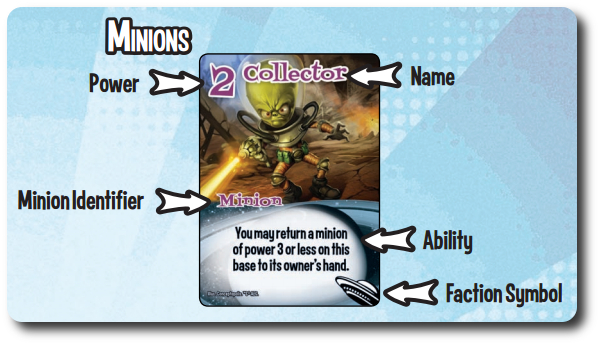
Action Cards
Action cards are typically one-time abilities that are used and then discarded. Actions range from moving Minion cards from one Base to another, destroying Minions, providing the ability to play additional Minions, or an ongoing effect that stays active as long as the card is in play.
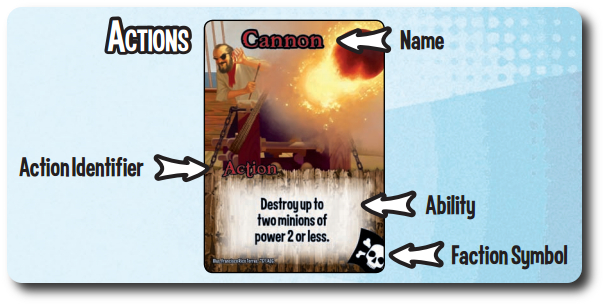
Base Cards
These are the cards that are attacked my Minions. They have a Breakpoint value that is compared against the combined strength of the Minions attacking the Base. If the strength of the Minions exceeds the Breakpoint value, the Base is destroyed and Victory Points are awarded. Each card has three Victory Point values. The player who had the most combined Minion strength gets the winner Victory Points, the player with the second highest combined strength gets the runner-up Victory Points, and the third highest strength gets the third place Victory Points. Some Base cards also have an Ability that is used while it is in play.
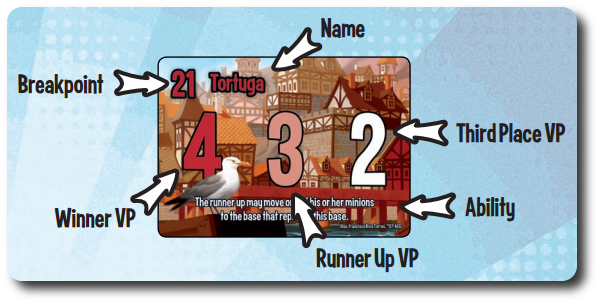
Playing The Game
Note: The game play is only summarized here. Review the game’s rule book for complete details.
On a player’s turn, they will first determine if they have any effects or abilities that are triggered.
Then the player can decide to play one Minion card, one Action card, or one of both. Minions are played to a Base card. Actions are revealed to the table and then the Action is resolved. Actions are then placed in the player’s discard pile, unless it has an ongoing effect.
After playing their cards, the player checks each of the Base card’s Breakpoints. If the Breakpoint has been exceeded on the Base, it is scored.
The last thing a player does is draw 2 cards from their Faction deck. The maximum number of cards a player can have in their hand is 10 after drawing their 2 cards. If the player has more than 10 cards, they must discard down to 10.
But right before the player’s turn ends, any “end of turn” abilities or effects are triggered! Play then passes to the left.
Winning the Game
After every Base is scored, check to see if any player has 15 or more Victory Points. If so, the game is over and that player is the winner.
To learn more about Smash Up, visit the game’s web site.
Final Word
At its heart, Smash Up is a simple card game along the lines of Fluxx (we’ve reviewed Cthulhu Fluxx and Oz Fluxx, if you are interested), but not nearly as chaotic. You play an Action, play a Minion (or both), and then draw two cards. The goal is to always gain Victory Points by destroying Bases. The strategy of this game is focused on trying to synergize two faction decks with each other for maximum damage, as each faction plays differently. For example, Dinosaurs are very powerful and have high strengths, Zombies are weak but keep coming at you by special actions that allow additional Zombies to be played from the hand and the discard pile, and Pirates can easily move from Base to Base. This adds to the replayability of the game since you can mix two different factions each time you play. One drawback is that some faction combinations seem to be stronger than others, resulting in some balancing issues that cannot be avoided.
Of all three geek groups, I think Smash Up works best with the Child Geeks. Kids are drawn towards dinosaurs, wizards and aliens. As soon as the box is opened, they will be very intrigued by the game. The art style is very cartoony and child friendly so there is no need to worry about images of scary zombies. As stated before, the rules are simple and as long as the kids can read and understand the cards, they can play the game. Smash Up is highly recommended for this group and was eagerly approved by them.
For the Parent Geeks, Smash Up is a quick game to learn and easy to play. The game play is very casual and light. There’s enough strategy to keep people interested, but it’s not so deep that it will lead to long periods of analysis paralysis. In fact, if you are thinking a lot on your turn, you are most likely playing the game wrong. The Parent Geeks approved of Smash Up with a smile.
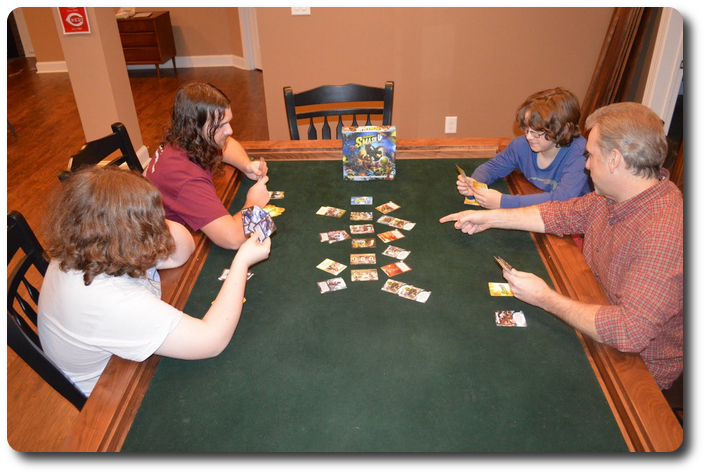
Explaining the game to my little geeks…who aren’t so “little” anymore
The Gamer Geeks also approved of Smash Up! They found it to be the perfect box of choice to slap on the table when a quick, fun game was needed. All the Gamer Geeks agreed that Smash Up was an excellent game filler or the perfect mental break between heavier games. A very light game indeed, but an enjoyable one to play. No deep strategy or tactics here, but what it lacks in depth is makes up for in speed and fun.
Smash Up is a game that tries to answer those questions geeks have debated for years. What would happen if you mix aliens and zombies? Wizards and robots? It’s a pop culture mashup…err…smashup. Don’t try to reason why these factions would team up in the first place, because that is not the point. Just combine them, give the Faction deck a shuffle, and enjoy the ride. And who knows, maybe the MOTHER OF ALL QUESTIONS that asks who is the greatest, Pirates or Ninjas, will finally be answered!
Unless they team up and fight side-by-side…hmmm…
[Note from the Editor: Dang it, Marty! Now I’m going to be thinking about a Pirate Ninja army all day! Gah!]




Great review, Marty! Thank you very much for taking the time to write it up and share it with us.
I was not so enamored by this game. I found it to be too long and too random. Tactics and strategy can be used to win the game, but I found myself way too distracted with cards that were doing nothing to help me or too many annoying cards being played by my opponent’s to make much progress in the game.
More game plays are needed until I feel I can properly state my final thoughts on it.
That’s why I was on the fence with it being Gamer Geek rejected. It’s not a game that gamers are going to purposely get together to play. But in our group we find it as a filler as we wait on a straggler or play in between games as we wait on the pizza to arrive 🙂
Not every Gamer Geek likes what their fellow Gamer Geeks might or might not like. That would be silly and pretty boring. Smash Up is getting much love from the Gamer Geeks of the world and I see no reason to disagree with them. To suggest that a game is “bad” simply because one does not like it is very arrogant. To suggest a game is “not for you” after playing it multiple times and giving it your full attention is wise.
Save me a slice of that ‘Za, Marty!
Pingback: Weather Wars (prepublished version) » Father Geek
Pingback: Super RPS: Rock • Paper • Scissors Game Review » Father Geek
Pingback: IncrediBrawl Game Review (prepublished version) » Father Geek
I have to disagree here. I think Smash Up may have been a quick and light filler game when it first came out, but the expansions have now brought the number of factions from 8 to 46! There is a substantial amount of strategy that goes into drafting your factions and putting them against your opponents.
In my gamer group, we have gotten together at least 5 times just to play Smash Up. Two of my buddies loved I so much they have each purchased at least one set.
My parent group is the one that struggles; the rules are simple, but the deeper strategies have a fairly steep learning curve. So new players will lose to experienced players unless the experienced players even out the game during faction drafting. (Give the new guy a really strong combo and yourself something that doesn’t synergies well, and the game will be pretty even.)
That said, the games usually have a fairly close score due to the mechanics of scoring, since first, second, an third place will all get some points usually.
Pingback: Evil Overlord Game Review (prepublished version) - Father Geek
Pingback: Smash Up: The Bigger Geekier Box Expansion Review - Father Geek
Pingback: Dragonrealm Game Review - Father Geek